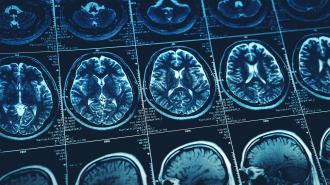There is no doubt that Greg Teasley has prepared for this phone interview more than I have.
“I spent hours writing these notes, over and over again,” Teasley says. He’s got an opening summary, impacts categorized, the way he manages them, all laid out with architectural precision so he remembers what he wants to say. After having two parts of his brain removed following traumatic injury, Teasley suffers from severe memory loss; he lives in a transient world that’s almost impossible for us to understand. That’s why he’s been excitedly researching efforts to restore active memory, including brain implants.
For now, Teasley’s recall is severely limited. “Seconds,” Teasley chuckles. “It’s seconds and it’s gone.”
After our interview is over, Teasley likely won’t be able to tell you what we’ve talked about. Our respective notes, my recording, the emailed introductions and logistical details; these are the only evidence he will have that the interview existed.
He hasn’t read a book in years. Each song he listens to is new, or a ghost. He recalls numbers best; he’s always been good. He might remember hanging out with you, but not what you’ve talked about. Anxiety accompanies social occasions. Kind humor from those around him helps, but he struggles with depression and anxiety. The condition makes it impossible for him to hold a job, and taking his college classes difficult — although he surely takes better notes than everyone else. And GPS is a godsend.
Our respective notes, my recording, the emailed introductions and logistical details; these are the only evidence he will have that the interview existed.
“It’s really difficult for people to understand what I’m going through,” Teasley says.
To live in such a phantom world, Teasley turns Joan Didion, taking notes and photos on his phone as everything unfurls. He color codes, italicizes, writes things over and over again, alphabetizes, and links numbers with words. He’s been told scented markers may help, to associate a scent with that he wants to remember. It is a challenge, for both him and those around him.
But he has hope.
Brain Implants: A Defibrillator for Memory
Names are nearly impossible for Teasley to keep, unless they make a deep impact. But Dan Rizzuto’s name has stuck with him throughout the course of his research.
That’s because his work with Mike Kahana at the University of Pennsylvania may one day change Teasley’s life. They have developed a brain implant that improves memory.
The concept is so simple it almost sounds like science fiction. The brain implant’s algorithm can determine when a user is struggling to remember. When the user’s memory is functioning normally, the device does nothing. But when it detects that a patient is having trouble recalling a memory, the implant stimulates the brain, giving it a targeted electric boost. Think of it like a defibrillator: when the heart is beating as normal, nothing happens. When the heart misfires, an electric jolt puts it back on track.
In practice it’s more complex, of course. The brain is an inscrutable black box. A running theme with every neuroscientist and psychologist I’ve ever interviewed is just how much we don’t know. Making it even more difficult, the kind of detailed information researchers needed to develop their own brain implants could only be measured invasively. Since people are not likely to volunteer to get a burr hole drilled into their skulls without any benefit, researchers like Rizzuto and Kahana or Read Montague at Virginia Tech use patients who are already receiving brain implants of their own.
Turns out the ideal candidates were people with epilepsy. A subset of epilepsy patients receive implants which involve putting a hundred or more electrodes in their brains. These neural implants keep tabs on electrical activity during epilptic seizures. But researchers realized they can be used to measure more than that. Rizzuto and Kahana gathered data on what was happening electrically inside one patient’s brain during repeated memory tests.
The key measurements are what’s called high frequency activity (HFA) and low frequency activity (LFA) in the brain. HFA means faster electrical pulses; LFA means the opposite.
“What you see during good memory is an increase in those high frequency oscillations, the HFA, and a decrease in the low frequency oscillations,” Rizzuto says.
This data is crunched by a bespoke machine learning algorithm — it’s simply too much information for a human to handle — and the end result is a personalized signature of a patient’s good and bad memory states.
The memory implant is a closed loop system, taking real-time stock of the brain’s memory state, and delivering the stimulation only when it is needed. The results, backed now by multiple studies, show an 18% increase in memory performance. Rizzuto believes that performance will get better; as is, they only have limited time with the patients, and the placement of their electrodes is dependent on their epilepsy treatment, not where it would boost memory best.
When the brain implant detects that a patient is having trouble recalling a memory, it stimulates the brain by giving it a targeted electric boost.
Now the technology must go from the lab to a device that can be safely and effectively used clinically to eventually find its way into patients like Greg Teasly. Rizzuto and Kahana have founded Nia Therapeutics, based on the Main Line, the rolling edenic enclave of old money outside Philadelphia, to achieve just that.
‘You Can’t Just Keep Them in the Hospital’
The memory stimulator’s closed-loop capability aims to ensure nuance. In addition to only stimulating a particular region of the brain, the machine learning algorithm’s ability to read the brain states means it only fires when appropriate. This is in comparison to an open-loop system like deep brain stimulation for Parkinson’s patients; once their stimulator is dialed in, it fires constantly.
While the system is nuanced, the equipment was not. Patients had to be in the hospital , and were hooked to a rack of equipment rolled in each day, connected by the wires protruding, in a medical Medusa ‘do, from their skulls.
“When we’re talking about going into a patient with traumatic brain injury, you can’t just keep them in the hospital the entire time with a rack of equipment next to them,” Rizzuto says.
The brain implants will need to be fully implantable, safe, and effective to be used outside of the hospital. As it stands currently, people like Greg Teasley would not be able to reap the benefits of Rizzuto and Kahana’s work.
That is Rizzuto’s next challenge.
Translational Medicine: Bringing Memory Implants to Those Who Forget
Jumping from the lab to the clinic is a challenging endeavor. There is hardware to be perfected and efficacy standards to prove for that new device. The procedure, which carries the inherent risks of any surgery, much less brain surgery, needs to be streamlined and made safe.
Nia is developing the clinically available version of the brain stimulator right now, Rizzuto says. A major hurdle was already cleared when the company acquired the chipset needed to run their stimulation algorithm — this is separate from the good/bad state signature detecting algorithm — from Cortera Neurotechnologies. And the first engineering prototype has been developed, a 1.5 inch by 1.5 inch cube. The vision is for the implant to go in the brain, coupled with a small device which will hug the ear and and contain the chipset and device’s battery.
“It eliminates the number one risk of implantable medical devices, and that’s battery acids in the body,” Rizzuto says. The stimulation algorithm will communicate with the memory implant through a wireless antenna, the same approach that cochlear implants use. Keeping everything but the stimulator outside of the skull will also make it easy to upgrade, Rizzuto says.
Nia has already met with the FDA to begin laying the groundwork for their clinical trials. The first cohort will be patients who suffer memory impairment from moderate to severe traumatic brain injury. Rizzuto believes they are two years out from beginning human trials. There are a few other teams looking at using DBS for treating TBI and Alzheimer’s, but none are utilizing a closed-loop and target system like Nia’s, Rizzuto says.
Current studies show an 18% increase in memory performance. Dan Rizzuto believes that will get better.
And TBI patients may just be the beginning. “We believe this technology can be used to treat other types of memory impairments,” Rizzuto says. “From mild cognitive impairment to, someday, Alzheimer’s disease.” And his ambitions reach beyond the pathological. “The real long tail possibility here that’s very exciting is someday being able to treat healthy aging.”
After all, most everyone will suffer some form of memory impairment as we age.
“I would wear an entire helmet if that’s what it took,” Teasley says. If he and people like him could write less lists; feel more confident going into a social situation; be able to hold a job, get off disability, the change could be profound.
Dan Rizzuto’s name sticks with him for now.





